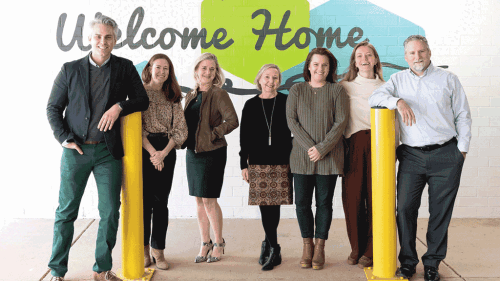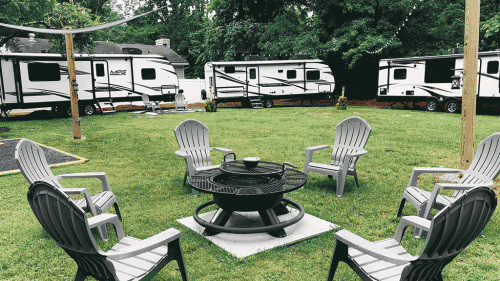Shanghai’s Huangpu River offers some of the best views in the world, with the historic Bund on one side and the science-fiction-like skyline of Pudong on the other; now, the Huishan North Bund project has created a new model of waterfront development.
The colonial-era Shanghai Bund is one of the city’s major sights, especially since 2010, when it was remodeled to make it more attractive and accessible. However, there is more to Shanghai’s waterfront than this tourist attraction; former industrial areas are being revitalized to create new developments that allow for public access to the river and which will eventually link together, creating several kilometers of walkable waterfront.
North of the historic Bund, along the Puxi side of the Huangpu River, what was once a busy commercial dock has been transformed into a modern 2.8 million-square-foot (255,000 sq m) mixed-use development, centered on a marina and with eight buildings in a green and open setting and an underground shopping street.
Developed on 2,000 feet (600 m) of river frontage, Huishan North Bund is part of a larger development running 1.2 miles (2 km) north from Shanghai’s new international cruise terminal in the Hongkou Waterfront District. The project has been developed as a joint venture between two state-owned enterprises—developer Franshion Properties and landowner Shanghai International Port Group, whose new headquarters and trading facility are part of the Huishan development.
Waterfront land in central Shanghai is now at a premium, and the ports group has moved the bulk of its commercial facilities further from the center with the construction of the Yangshan Port, freeing up the North Bund riverside for the first time in the city’s modern history.
“After more than 200 years, during which this historically significant stretch of riverfront was occupied by commercial maritime uses and thus closed to the public, Huishan North Bund has become Shanghai’s next great place, reuniting citizens with their waterfront by means of a public plaza that dominates the site, an esplanade, and a marina that serves as the centerpiece of the development,” says Ming Wu, design principal at architect Perkins Eastman, which designed the Huishan North Bund project. The design project was awarded to EE&K in 2008 and the firm merged with Perkins Eastman in 2011.
Huishan North Bund has spectacular views toward the Lujiazui financial district on the Pudong side of the river, one of the world’s most dramatic modern cityscapes. Office tenants and visitors get prime views of China’s tallest building—the 2,073-foot (632 m) Shanghai Tower—and another four skyscrapers of 984 feet (300 m) or higher. One of these is the 1,200-foot (420 m) Jin Mao Tower, once the tallest building in China and a project of Franshion Properties.
Wu says: “We had two design objectives: firstly to maximize views and secondly to produce a set of office buildings with enhanced identities to differentiate each building. Furthermore, we wanted to create spaces that established a unique place for both users and visitors.”
Each new building features a green roof, ice storage, operable windows, and raised floor systems to increase energy efficiency; and varied glass, steel, and terra-cotta facades designed for the controlled absorption of abundant sunlight as well as reflective light from the marina.
He Binwu, executive director and vice president of Franshion Properties, has been overseeing the entire development, including the new cruise terminal, which opened in 2010. The cruise terminal, designed by Frank Repas, is an extravagant design featuring three brightly colored, egg-shaped suspended sections. As a result, the recently completed Huishan North Bund development had to be more restrained, He says.
“The cruise terminal has a very modern, colorful facade, and some people in government prefer a more traditional style, which is what we have adopted for the rest of the development,” He says.
Chinese and European Influences
When one walks around the Huishan marina, it is striking how open and calm the development is, with a distinctly European feel due to the lower building heights, which means the buildings do not crowd the marina. The European feel is maintained despite the use of very Chinese terra-cotta, which provides a unifying feature on the buildings’ exterior.
Wu says, “Planning regulations limit the height of the front row of buildings along the waterfront; the municipal planning department is quite democratic about access to views. This also has the effect of making Huishan built on a more human scale.”
Building heights on the site are limited to 328 feet (100 m), except for the new headquarters of Shanghai International Port Group. This was a 427-foot-tall (130 m) structure, which was already on site. Faced with a choice of flattening the building and rebuilding to the lower height, the developers decided instead to strip back the structure to its very core and completely rebuild it in order to keep the extra height.
Such an ambitious project might not have been attempted in other markets. However, China still has sufficiently low construction costs that make such an undertaking feasible. The nation also has ambitious state-owned companies, which have the will and capacity for such projects.
The European feel to the development is also intentional. St. Katherine’s Dock in London has been a particular inspiration, He Binwu says. Ideas have also been generated from the friendship between He Binwu and George Iacobescu, chief executive of Canary Wharf Group, which was the developer of London’s Docklands financial district.
The 129,000-square-foot (12,000 sq m) marina, accessed by a lock gate from the river and capable of handling boats up to 131 feet (40 m) long, is the major focal point and maintains a connection with the site’s maritime history. So do the squat steel mooring posts, which have been left in place at the water’s edge as a link with the busy commercial dock of the past.
“The marina was a way to create an attraction and a unique marketing brand; everyone likes the spectacle of big yachts,” says Wu. The marina is also central to environmental management of the site, acting as an innovative but natural force that moderates the temperature by absorbing heat in the summer and emitting it in the winter.
With its water refreshed from the river each time the lock gate is used, the marina is also an important factor in the sustainability of the project, providing heat rejection for all the buildings’ air conditioning and precluding the need for cooling towers on site. It also collects all the site’s stormwater.
Below the marina, which Wu likens to a bathtub, there are three levels of parking, providing 1,400 spaces and a tunnel service road, which runs along the whole of the development.
Resource Efficiency
The marina is a large enough body of water to create a beneficial microclimate for the surrounding plaza through evaporative cooling in warm months and as a warming body of water in winter. “The marina alone saves 15 to 25 percent on energy costs in any given year,” says Wu. “It’s not just a pretty attraction.”
Energy efficiency is important to the development, which has motorized opening windows and natural ventilation, which, according to He Binwu, means that additional heating or cooling is not required when the temperature is between 61 and 72 degrees Fahrenheit (16 and 22 degrees C). “This is about half the year in Shanghai,” he notes.
The development has a central facility for managing and tracking energy use and which is also an important factor for the ongoing management of a development where individual buildings are being sold to occupiers. He Binwu is keen to stress that the Franshion model is not to build, sell, and forget, but to maintain the development.
A core aspect of the development is accessibility, for the practical reason of getting people to work, for reasons of sustainability, and to allow for easy public access to the site. “We have four metro lines running close to the site, and workers will be able to exit two metro stations directly to the underground retail,” says He Binwu.
The landward side of the site is open, permitting views through from neighboring buildings and multiple access points for the public. Wu says, “We wanted the inland edge of the site to be very porous, so people can easily find their way to the waterfront.”
The development has Leadership in Energy and Environmental Design (LEED) Gold shell and core certification and is targeting a Three Star green building rating, which is roughly China’s equivalent of LEED Gold/Platinum.
However, Wu notes: “At first, sustainability was not a major concern. The development was started in 2008, which is eons ago in China! Developers and end users were not so focused on sustainability and quality of life. However, as the plans progressed, sustainability became a more important factor in China and to the North Bund, so we jumped in with both feet to create an important sustainable development.”
Subterranean Uses
A significant part of the development is hidden below ground. There are several parking levels, an underground retail concourse, and the roots of each building contain conference and cafeteria spaces with access to the shops. Furthermore, the site has an underground road that can be accessed by emergency services. “The below-grade element of the development is such that it accounted for two-thirds of the overall construction costs,” Wu notes.
The underground retail street is accessible from each building and from outside, which creates light wells. The underground shops and restaurants, some of which are already fitted out, will serve the office workers. However, higher-end restaurants looking out over the marina will be opened, He Binwu says. He says that he hopes that Huishan will become a dining destination.
Keen to make the plan part of the community, the developers have already held a number of public events at the marina and on the esplanade, with more events planned.
Seen from above, the development looks remarkably green, with clusters of trees and other vegetation planted liberally between the buildings to the extent that nearly 45 percent of the site is vegetation. “Trees are part of the design to make the site green and lush, to provide shade and cooling, and to add to the attractiveness of the setting,” says Wu. Each building has a green roof, which will offer occupiers a chance to relax and enjoy the views toward Lujiazui and north and south along the riverside.
A common misconception about new development in China is that structure quality is sacrificed to shorten construction time and maximize profit. This may be the case for smaller developers and more modest projects, but developments like Huishan are built to very high specifications, and developers such as Franshion are deeply concerned about quality.
Bearing in mind the cost of the site, Franshion’s He Binwu says that everything must be produced to the highest quality in order to get the most value out of the site. Because it provides some of the best office space in Shanghai, with greater floor-to-ceiling heights and the views, He Binwu says he believes it will become a popular headquarters site for major state-owned enterprises.
To sum up the architectural challenge of Huishan and how that challenge was met, Wu says: “We viewed the design problem in two parts: the office buildings and retail offering comprising the business agenda, and the ground plane of plaza, esplanade, and marina forming the ‘civic’ agenda.
“Our solution was sectional in nature, and quite simple. By elevating the office buildings from seven to nine meters [23 to 30 ft] above the ground plane while burying the retail component as a concourse below grade, we freed up the entire ground plane to become the public domain, permitting free movement by the public throughout the site, around the marina, and to the riverfront.
“So, in effect, the public realm—sandwiched between two slices of programmed uses—dominates one’s perception of the development and establishes a sense of place. In a nutshell, Huishan is about enjoying skyline and river views from the best seats in the house, and about returning a waterfront to its community.”
Mark Cooper is editor of AsiaProperty magazine.












